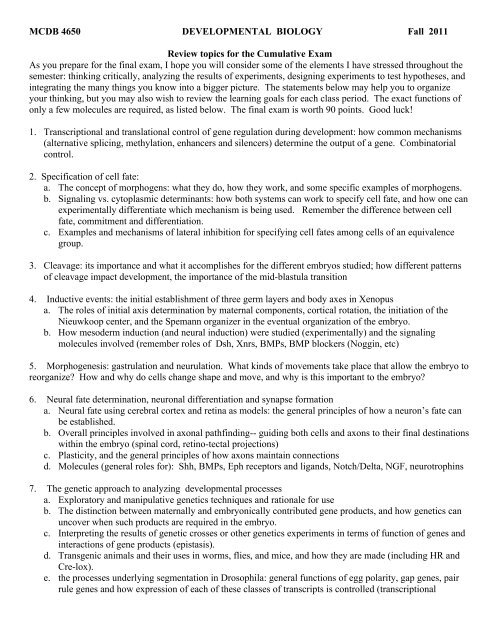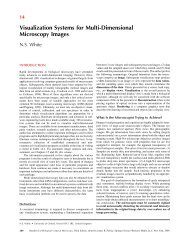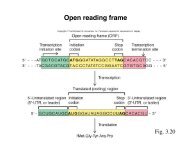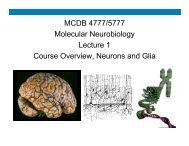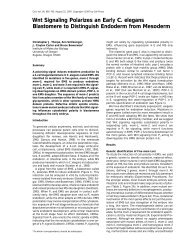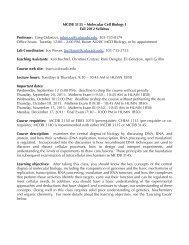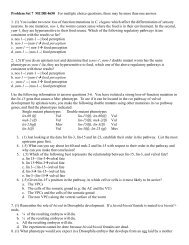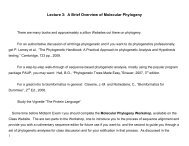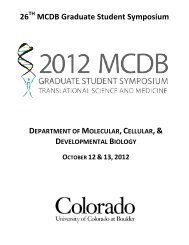Final exam Review Sheet - MCD Biology
Final exam Review Sheet - MCD Biology
Final exam Review Sheet - MCD Biology
You also want an ePaper? Increase the reach of your titles
YUMPU automatically turns print PDFs into web optimized ePapers that Google loves.
<strong>MCD</strong>B 4650 DEVELOPMENTAL BIOLOGY Fall 2011<br />
<strong>Review</strong> topics for the Cumulative Exam<br />
As you prepare for the final <strong>exam</strong>, I hope you will consider some of the elements I have stressed throughout the<br />
semester: thinking critically, analyzing the results of experiments, designing experiments to test hypotheses, and<br />
integrating the many things you know into a bigger picture. The statements below may help you to organize<br />
your thinking, but you may also wish to review the learning goals for each class period. The exact functions of<br />
only a few molecules are required, as listed below. The final <strong>exam</strong> is worth 90 points. Good luck!<br />
1. Transcriptional and translational control of gene regulation during development: how common mechanisms<br />
(alternative splicing, methylation, enhancers and silencers) determine the output of a gene. Combinatorial<br />
control.<br />
2. Specification of cell fate:<br />
a. The concept of morphogens: what they do, how they work, and some specific <strong>exam</strong>ples of morphogens.<br />
b. Signaling vs. cytoplasmic determinants: how both systems can work to specify cell fate, and how one can<br />
experimentally differentiate which mechanism is being used. Remember the difference between cell<br />
fate, commitment and differentiation.<br />
c. Examples and mechanisms of lateral inhibition for specifying cell fates among cells of an equivalence<br />
group.<br />
3. Cleavage: its importance and what it accomplishes for the different embryos studied; how different patterns<br />
of cleavage impact development, the importance of the mid-blastula transition<br />
4. Inductive events: the initial establishment of three germ layers and body axes in Xenopus<br />
a. The roles of initial axis determination by maternal components, cortical rotation, the initiation of the<br />
Nieuwkoop center, and the Spemann organizer in the eventual organization of the embryo.<br />
b. How mesoderm induction (and neural induction) were studied (experimentally) and the signaling<br />
molecules involved (remember roles of Dsh, Xnrs, BMPs, BMP blockers (Noggin, etc)<br />
5. Morphogenesis: gastrulation and neurulation. What kinds of movements take place that allow the embryo to<br />
reorganize? How and why do cells change shape and move, and why is this important to the embryo?<br />
6. Neural fate determination, neuronal differentiation and synapse formation<br />
a. Neural fate using cerebral cortex and retina as models: the general principles of how a neuron’s fate can<br />
be established.<br />
b. Overall principles involved in axonal pathfinding-- guiding both cells and axons to their final destinations<br />
within the embryo (spinal cord, retino-tectal projections)<br />
c. Plasticity, and the general principles of how axons maintain connections<br />
d. Molecules (general roles for): Shh, BMPs, Eph receptors and ligands, Notch/Delta, NGF, neurotrophins<br />
7. The genetic approach to analyzing developmental processes<br />
a. Exploratory and manipulative genetics techniques and rationale for use<br />
b. The distinction between maternally and embryonically contributed gene products, and how genetics can<br />
uncover when such products are required in the embryo.<br />
c. Interpreting the results of genetic crosses or other genetics experiments in terms of function of genes and<br />
interactions of gene products (epistasis).<br />
d. Transgenic animals and their uses in worms, flies, and mice, and how they are made (including HR and<br />
Cre-lox).<br />
e. the processes underlying segmentation in Drosophila: general functions of egg polarity, gap genes, pair<br />
rule genes and how expression of each of these classes of transcripts is controlled (transcriptional
2<br />
activators and repressors; combinatorial control!), and how the genetic approach was important for<br />
discovering all of this!<br />
8. Roles of Hox genes in Drosophila, amphibians, and mammals. Be familiar with the general phenotypes of<br />
LOF or GOF mutations in Hox genes, and the importance of their conservation across all animals.<br />
9. The principles that underlie limb patterning: models for explaining the patterning, and the involvement of<br />
different molecules and their interactions in establishing the different axes, and the conservation of limb<br />
development across animals.<br />
10. Sex determination, Dosage Compensation and Imprinting<br />
a. Primary and secondary sex determination in mammals (molecules: SRY, AMH, testosterone), compared<br />
to sex determination in C. elegans and Drosophila (X:A ratio)<br />
b. General mechanisms of dosage compensation (differences, similarities between C. elegans, Drosophila<br />
and mammals) and X chromosome inactivation in mammals (Xist).<br />
c. Imprinting: possible evolutionary reasons, general mechanism, and how to determine which copy<br />
(maternal or paternal) is imprinted (be able to interpret experiments or crosses to figure out which copy is<br />
imprinted)<br />
11. Stem cells and their uses, medical implications<br />
a. general properties of stem cells (progressive restriction; committed stem cells vs. multipotent stem cells)<br />
b. embryonic stem cells: developmental potential, ways to control differentiation, difference between<br />
reproductive and therapeutic cloning<br />
c. clinical potential of therapeutic cloning and iPS cells.


